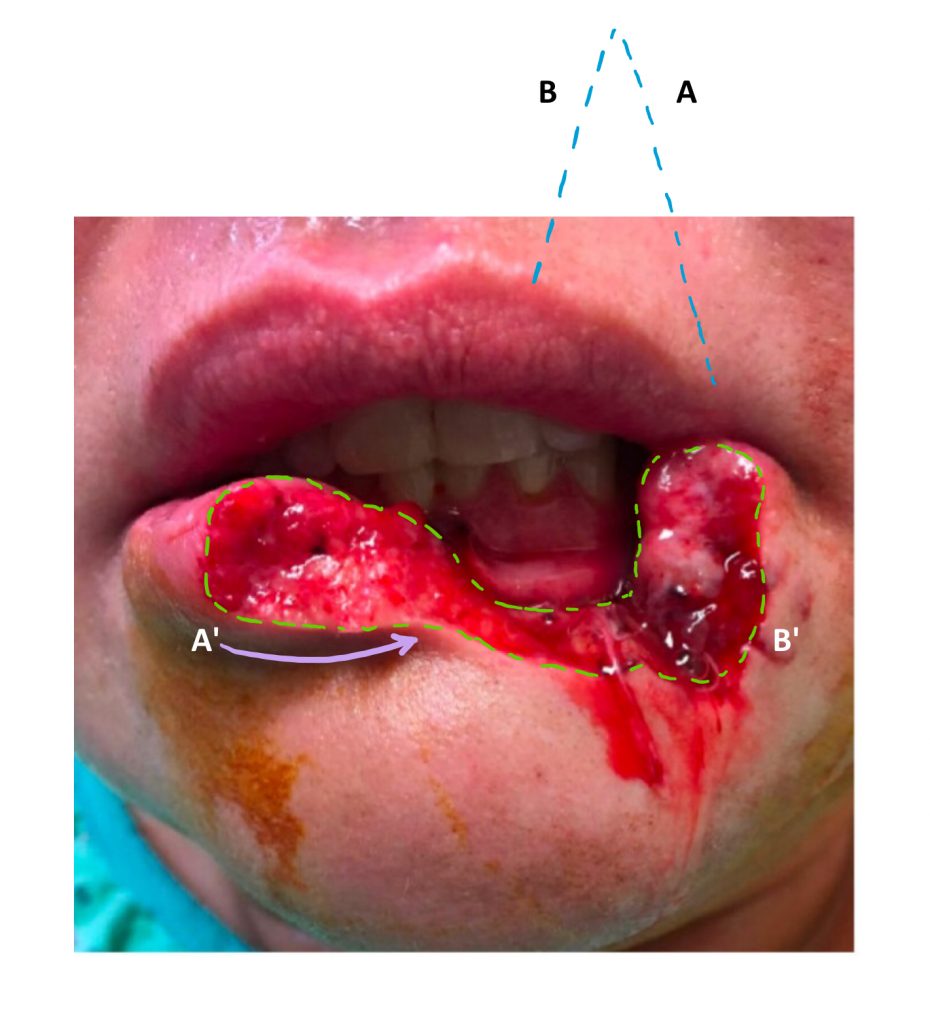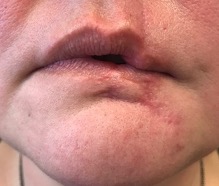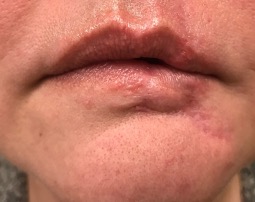Lip Scar Correction
History:
A 38-year-old Caucasian female with a history of a facial dog bite resulting in avulsion of 30% of her lower lip presented to the plastic surgery clinic with concerns of unacceptable lip appearance and oral incompetence. Initial closure was deemed inadequate, and she underwent an Abbe flap closure followed by division of the Abbe the flap by OMFS four and five months respectively after primary injury. She desired revision for better appearance and to improve her oral competence.

Initial injury showing avulsion of the lower lip including the vermillion border. Blue dotted line denotes the approximate location of the Abbe flap. The purple arrow indicates advancement of tissue medially, with A-A’ and B-B’ denoting match points between the flap and inferior lip. The green dotted line outlines tissue that was further debrided.
Findings:
Eight months later, there was a step-off deformity of the upper lip with malalignment of the vermillion border, decreased fullness of lower lip and hypertrophic scarring leading to puckering suggestive of a mal-positioned orbicularis muscle.

Pre-operative photo showing a step off deformity and mal-alignment of the vermillion border in the upper lip in Abbe flap donor area. Scarring and lack of volume in lower lip.
Diagnosis:
Late result of lip laceration with hypertrophic scarring and malalignment of vermilion and orbicularis muscle.
Differential Diagnoses:
Workup Required:
No additional workup was required.
Plan:
For the lower lip hypertrophic scarring, intralesional Kenalog injections were recommended. This treatment would be completed prior to a surgical revision.
To address the lack of lower lip fullness, it was discussed that fat grafting would best restore volume. Risks such as significant scarring and need for repeat sessions were discussed, and the patient was agreeable to this plan.
Regarding the upper lip vermilion border step off defect, the patient would require full thickness excision of scar and realignment of the vermilion border via local tissue rearrangement and Z-plasty, with careful attention to ensure appropriate alignment of the orbicularis muscle. The patient was advised that there was no guarantee of improvement in her oral incompetence, and that there was a small risk that it could worsen. The patient elected to move forward with treatment.
Expertise Needed:
A plastic surgeon with expertise in soft tissue injury was required.
Treatment:
The patient was treated with 3 cc of 50/50 mixture of kenaolg 40 and 1% lidocaine with epinephrine over 3 sessions to address lower lip hypertrophic scarring. Upon completion of the injections, the patient underwent excision of the scar with realignment of the vermillion border and orbicularis muscle.
The two misaligned borders were marked and injected with local anesthetic (50/50 mixture of 1% lidocaine with epinephrine and 0.25% Marcaine). An incision was made on the lower lip vermilion border and a Coleman fat injection cannula was used to inject 3 cc of fat into the lower lip collected from the abdomen to give more fullness to the lip in the central lateral and lateral aspect of the lower lip where there was significant contracture from the Abbe flap. The scar was released completely by incising through the cutaneous portion of the upper lip and continued down through the dry and wet vermilion borders of the lip. A 5-0 Monocryl suture was placed in the deep dermal layer to realign the vermillion border. Two horizontal mattress sutures were placed with a 2-0 Monocryl suture to realign the orbicularis. After muscle alignment, it was clear that the dry portion of the vermilion required advancement of the medial lip flap in a Z-plasty fashion. A counter incision in the lateral lip flap was made to allow the inset of the medial Z-plasty limb, accomplished with a 5-0 Monocryl. Excess tissue was trimmed along the lateral lip and inset with 5-0 Monocryl in deep tissue, 3-0 chromic on the wet vermillion, and 5-0 chromic on the dry vermillion. It was clear at this point that the patient would require further fat grafting to address the lateral vermilion border of the lip. A dressing with Bacitracin ointment was applied along the lip. Liposuction sites were closed with 5-0 fast gut and covered with Steri-Strips, gauze, and a Tegaderm dressing.
Follow Up:
The patient was seen 6 weeks post operatively with no complications. She returned to the clinic five months post operatively desiring additional fat grafting. Additional fat grafting was performed, leading to a satisfactory final result.

A post-operative photo showing improved step off deformity, enhanced alignment of the vermillion border, and improvement in hypertrophic scarring.

